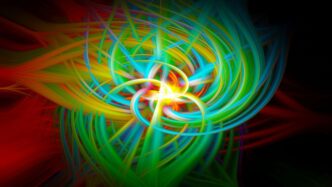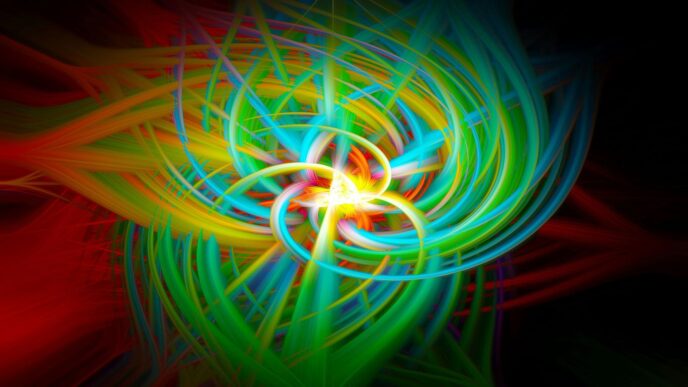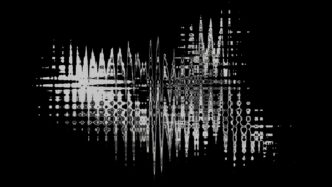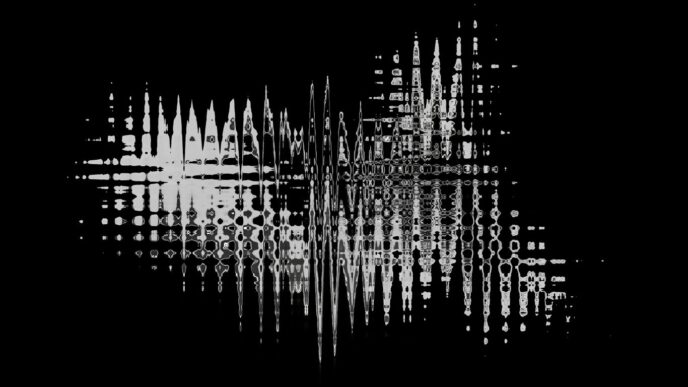You’ve probably heard the word “quantum” thrown around a lot lately, from computers to companies to even explaining things like love. So, what’s the deal with quantum? Is it all just hype? Well, to put it simply, quantum mechanics is all about how the tiniest bits of the universe behave. It’s a bit like looking at a picture up close and seeing it’s made of individual dots – the quantum world is like that, but with the fundamental pieces of matter and energy. Understanding what is a quantum in chemistry helps us grasp why things in the world are the way they are, from how atoms stick together to how materials behave.
Key Takeaways
- The quantum world deals with the smallest parts of matter and energy, behaving differently than the larger objects we see every day.
- The properties of all matter are shaped by quantum physics, influencing how atoms bond and form molecules.
- Quantum theory wasn’t born in a vacuum; it emerged from scientists trying to make sense of observations that didn’t fit older ideas.
- Key quantum ideas include superposition (being in multiple states at once) and entanglement (connected fates of particles).
- Quantum numbers are used to describe electrons in atoms, like their energy level and shape, and no two electrons can have the same set of these numbers.
Understanding the Quantum Realm
So, what exactly is this "quantum" thing everyone’s talking about? It’s basically the science that looks at the really, really tiny stuff in the universe – the bits that make up everything, including you and me. Think of it like zooming in on a digital picture. Up close, you see individual pixels, right? Well, if you zoom in on matter, way, way down, you eventually get to these fundamental pieces, these elementary building blocks, and they have their own weird rules.
The Granular Nature of the Universe
Our everyday world seems pretty smooth and continuous. You can slide a knife across a table, and it feels like one smooth motion. But at the quantum level, things aren’t so smooth. They’re more like a collection of tiny, discrete units. It’s like the universe is built from incredibly small LEGO bricks, not from a continuous block of clay. This granular nature means that energy, matter, and other properties come in specific, indivisible packets, or
Quantum’s Influence on Chemical Properties

So, how does all this tiny, weird quantum stuff actually affect the chemicals we deal with every day? Turns out, it’s pretty much everything. The way atoms stick together, how they behave, and what kind of materials they form – it all comes down to quantum rules.
Binding Forces Within Atoms
At the heart of it, atoms are held together by forces that are purely quantum mechanical. Think about electrons buzzing around the nucleus. Their behavior isn’t like tiny planets orbiting a sun; it’s much stranger. Electrons exist in specific energy levels, sort of like rungs on a ladder, and they can only occupy these discrete states. This electron arrangement dictates how an atom interacts with others. The specific way electrons are distributed around an atom’s nucleus determines its chemical personality. It’s like each atom has its own unique set of rules for how it can connect with its neighbors.
Electronic Structure and Bonding
When atoms decide to team up and form molecules, they do so by sharing or transferring these quantum electrons. This sharing or transfer is what we call chemical bonding. The type of bond – whether it’s a strong covalent bond where electrons are shared equally, or an ionic bond where electrons are completely given from one atom to another – depends entirely on the quantum states of the outermost electrons. This is why some elements readily form compounds while others prefer to hang out by themselves. Understanding the quantum mechanics of chemical bonding helps us predict how atoms will combine.
Predicting Material Behavior
Because the properties of individual atoms and the bonds between them are governed by quantum mechanics, the bulk properties of materials we see and touch are also a result of these tiny interactions. Whether a material is a conductor or an insulator, whether it’s hard or soft, or even what color it is, can often be traced back to the quantum arrangement of electrons within its atoms and molecules. For instance, the way electrons move in metals allows them to conduct electricity, a behavior rooted in their quantum states. It’s a cascade effect: quantum rules at the atomic level lead to the macroscopic properties we observe.
The Historical Roots of Quantum Theory
It’s easy to think of quantum mechanics as this super new, cutting-edge thing, but its roots go back over a hundred years. Back in the early 1900s, scientists were running into some serious problems. The physics they knew, the stuff that worked perfectly for describing baseballs and planets, just didn’t add up when they looked at the really, really tiny stuff, like atoms and light. It was like trying to use a ruler to measure something that was infinitely smaller than the smallest mark on the ruler – it just wasn’t going to work.
When Models Met Reality
Scientists were trying to explain things like how hot objects glowed. They had these mathematical models, but the predictions coming out of them were just plain wrong when compared to what they were actually seeing. It was a big puzzle. The old ways of thinking about energy and matter weren’t cutting it anymore. This mismatch between theory and observation was a big sign that something new was needed. It forced physicists to question their most basic assumptions about how the universe worked on its smallest scales. This period was a real turning point, pushing the boundaries of what was understood about the nature of light.
The Discovery of Photons
One of the key moments came when people were trying to figure out why light bulbs emitted different colors with varying brightness. They weren’t expecting to discover a whole new way of looking at the universe, but that’s exactly what happened. It turned out that light, which many thought of as just a wave, also behaved like it was made of little packets of energy. These packets were later named photons. This idea, that energy isn’t always continuous but can come in discrete chunks, was a really big deal. It was a radical departure from classical physics, which assumed energy could be divided infinitely.
Beyond Classical Intuition
So, what we learned was that the tiny world operates on rules that are totally different from our everyday experience. Things like energy and matter aren’t always smooth and continuous; they can be granular, coming in specific amounts. This led to a bunch of weird and wonderful ideas that still boggle the mind today:
- Wave-Particle Duality: Light and other tiny things can act like both waves and particles, depending on how you look at them.
- Quantization: Energy, for example, isn’t just any old amount; it comes in specific, discrete packets or
Key Quantum Concepts Explained
So, we’ve talked about how the universe gets pretty weird when you zoom way, way in. But what are the actual ideas that make quantum mechanics so different from what we see every day? Let’s break down a few of the big ones.
The Principle of Superposition
Imagine you’re flipping a coin. Before it lands, is it heads or tails? In our normal world, it’s one or the other, we just don’t know yet. But in the quantum world, a particle can actually be in both states at the same time. It’s like the coin is spinning in the air, being both heads and tails until it finally settles. This ability for a quantum object to exist in multiple states simultaneously is called superposition. It’s a bit like a dimmer switch for reality, not just on or off, but all the shades in between, all at once. This is a core idea that makes quantum computers potentially so powerful.
Understanding Entanglement
This one is even stranger. Entanglement is when two or more particles become linked in such a way that they share the same fate, no matter how far apart they are. Think of it like having two magic coins. If you flip them and one lands heads, you instantly know the other one landed tails, even if it’s on the other side of the galaxy. They are connected, correlated, in a way that classical physics just can’t explain. This spooky connection, as Einstein famously called it, is a key feature of quantum systems and has big implications for things like secure communication.
Wave-Particle Duality
This is where things get really mind-bending. You know how light can act like a wave, bending and spreading out, but it can also act like a particle, like a tiny packet of energy called a photon? Well, it turns out that’s not just for light. Electrons, atoms, and even larger molecules can also behave like both waves and particles. It’s not that they are one or the other, but rather that they exhibit properties of both depending on how you observe them. It’s like trying to describe a platypus – it has features of a mammal and features of a bird, and you can’t quite fit it into one box. Understanding this duality is key to grasping how atoms and molecules interact, which is the heart of quantum chemistry.
Here’s a quick rundown of how these concepts differ from our everyday experience:
- Classical World: Objects are in one specific state or location at any given time.
- Quantum World: Particles can exist in multiple states or locations simultaneously (superposition).
- Classical World: Events are independent unless physically connected.
- Quantum World: Particles can be linked (entangled) and influence each other instantly, regardless of distance.
- Classical World: Things are either waves or particles.
- Quantum World: Entities can exhibit characteristics of both waves and particles (wave-particle duality).
Quantum Numbers in Chemistry
So, how do we actually keep track of all these electrons buzzing around in an atom? It’s not like we can just draw a little map. That’s where quantum numbers come in. Think of them as an electron’s address, a unique set of numbers that tells us where it’s likely to be and what it’s doing. Every single electron in an atom gets its own special combination of these numbers. It’s kind of like how no two people have the exact same fingerprint, or, well, the same address.
There are four main quantum numbers we use:
- The Principal Quantum Number (n): This is the big one. It tells us the main energy level an electron is in, and also how far away from the nucleus it generally hangs out. Higher ‘n’ means a bigger energy level and a larger distance from the center. So, n=1 is the closest and lowest energy, while n=2 is further out and has more energy, and so on. You can’t have n=0 or negative numbers, because, well, you can’t have zero or negative energy levels.
- The Orbital Angular Momentum Quantum Number (l): This number describes the shape of the electron’s orbital. It’s like saying whether the electron’s space is a simple sphere (l=0, called an ‘s’ orbital) or something more complex, like a dumbbell shape (l=1, a ‘p’ orbital), or even more intricate shapes (l=2 for ‘d’ orbitals, l=3 for ‘f’ orbitals). The value of ‘l’ depends on ‘n’; it can range from 0 up to n-1.
- The Magnetic Quantum Number (ml): This one gets a bit more specific. It tells us about the orientation of the orbital in space. For a given ‘l’ value, there are a certain number of possible ‘ml’ values, which corresponds to the number of orbitals of that shape. For example, ‘p’ orbitals (where l=1) have three possible orientations in space (ml = -1, 0, +1), so there are three ‘p’ orbitals.
- The Electron Spin Quantum Number (ms): This is the last piece of the puzzle. Electrons have this property called ‘spin,’ which is a bit like them spinning on an axis, creating a tiny magnetic field. This spin can be either ‘up’ (+1/2) or ‘down’ (-1/2). It’s a bit like a coin flip for each electron within an orbital.
The combination of these four quantum numbers is unique for every electron in an atom, a rule known as the Pauli Exclusion Principle. This principle is super important because it dictates how electrons fill up the available orbitals, which in turn affects all sorts of chemical behaviors. It’s the reason why electrons in the same orbital have opposite spins – they have to be different in at least one way, and spin is the easiest way to do that when the other three numbers are the same.
Modern Interpretations of Quantum Mechanics
Fields as Fundamental Ingredients
So, we’ve talked about particles and waves, right? But some folks, like really smart physicists Steven Weinberg and Frank Wilczek, think we should shift our focus. They suggest that maybe the universe isn’t really made of tiny little balls or spread-out waves, but rather, it’s all about fields. Think of it like this: instead of seeing individual raindrops, you’re looking at the whole rain shower. These fields are everywhere, and what we call "particles" are just little bumps or excitations in these fields. It’s a bit like how a ripple on a pond is an excitation of the water itself. This idea helps explain a lot of things that the older "particle" or "wave" ideas struggled with. It’s a way to think about the basic stuff of the universe that’s a bit more unified.
Probability Distributions Over Particles
Remember how we talked about wave-particle duality? Well, a lot of the confusion comes from trying to picture these quantum things as either a wave or a particle. A more modern way to look at it is through probability. Instead of saying an electron is a wave or a particle, we say that the math of quantum mechanics tells us the probability of finding that electron in a certain place. It’s like rolling dice; you don’t know exactly what number will come up, but you know the chances for each number. So, when you do an experiment, you’re not observing a definite particle or wave, but rather, you’re seeing one possible outcome from a range of probabilities. This "probability cloud" is what the math describes, and it evolves over time.
The Role of Wave Packets
Okay, so if it’s not exactly a wave and not exactly a particle, what is it? Sometimes, scientists talk about "wave packets." Imagine taking a bunch of waves with slightly different lengths and adding them all up. Where they all line up just right, you get a peak, which can look a bit like a particle. But this peak isn’t a solid thing; it’s made of these overlapping waves. When these wave packets move, they can spread out, and that’s where the probability idea comes in again. The spread of the wave packet tells you about the uncertainty in the particle’s position and momentum. It’s a way to reconcile the wave-like behavior with the particle-like observations we make in experiments.
The Significance of Quantum in Chemistry
So, why should we even care about quantum stuff when we’re talking about chemistry? Well, it turns out, everything about how matter behaves, from the simplest atom to the most complex molecule, is dictated by quantum rules. It’s not just some abstract idea; it’s the very foundation of chemical properties.
Explaining Atomic and Molecular Behavior
Think about it: the way atoms stick together to form molecules, the colors that substances give off, or even why some materials conduct electricity and others don’t – it all comes down to the behavior of electrons. These tiny particles don’t just orbit the nucleus like planets around a sun. Instead, their locations and energies are described by probabilities, governed by quantum principles. This granular, probabilistic nature is what gives elements their unique chemical personalities and dictates how they interact. For instance, understanding electron configurations, which are directly derived from quantum numbers, helps us predict how atoms will bond. It’s like knowing the personality traits of individual people to guess how they’ll get along in a group.
The Pauli Exclusion Principle
This is a big one. The Pauli Exclusion Principle basically says that no two electrons in an atom can have the exact same quantum state. Imagine trying to assign seats in a theater; each person needs their own unique seat. Electrons are similar. Each electron in an atom gets a unique set of four quantum numbers (like an address), and if any one of those numbers is different, the electron is in a distinct state. This principle is super important because it explains why electrons fill up atomic orbitals in a specific order, which in turn determines the structure of the periodic table and the chemical properties of elements. Without it, all electrons would just pile into the lowest energy level, and chemistry as we know it wouldn’t exist.
Hund’s Rule and Electron Arrangement
Another key rule that helps us map out electron behavior is Hund’s Rule. It states that electrons will individually occupy each orbital within a subshell before doubling up. Think of it like people filling up seats on a bus; they’ll take an empty seat before sitting next to someone else. This rule, along with others, helps us predict the electron configuration of atoms, which is vital for understanding chemical bonding and reactivity. For example, knowing how electrons are arranged in an atom’s outer shell tells us a lot about how it will react with other atoms. It’s this detailed, quantum-level understanding that allows chemists to predict and design new materials, from advanced medicines to better batteries. The whole field of fintech relies on understanding complex systems, and chemistry is no different in its need for precise, rule-based behavior.
So, What’s the Takeaway?
Looking back, it’s clear that the ‘quantum’ buzzword isn’t just for show. It’s the bedrock of how atoms and molecules behave, which in turn shapes everything we see and touch. While the deep math and weird ideas like superposition and entanglement can feel a bit much, understanding the basic idea – that things get really different when you zoom way, way in – helps a lot. It’s not magic, just a different set of rules for the tiny stuff. Keep asking questions, stay curious, and who knows, maybe you’ll be the one figuring out the next big quantum thing.
Frequently Asked Questions
What exactly is a ‘quantum’?
Think of a quantum as the smallest possible piece of something, like a tiny Lego brick. In chemistry and physics, it’s the smallest amount of energy or matter that can exist. Things in the universe, especially at super tiny levels, come in these little packets, or quanta, instead of being smooth and continuous.
How does quantum stuff affect everyday things?
It might seem strange, but the way atoms stick together to form molecules, and how those molecules make up everything around us, is all guided by quantum rules. The colors you see, how materials feel, and even how your body works are all results of these tiny quantum interactions.
Is quantum mechanics a new idea?
Not at all! Scientists started figuring out these weird quantum rules over a hundred years ago. They noticed that their old ways of explaining the world didn’t quite work when they looked at really small things, like light or atoms. It was a whole new way of seeing how the universe operates.
What does ‘wave-particle duality’ mean?
This is one of the mind-bending ideas in quantum physics. It means that tiny things, like electrons, can act like both solid little balls (particles) and spread-out waves at the same time. It’s not that they change back and forth, but rather they have properties of both, depending on how you look at them.
What are quantum numbers for electrons?
Imagine electrons orbiting an atom’s center. Quantum numbers are like an address for each electron, describing its energy level, the shape of its path, and even its ‘spin’ (a kind of internal magnetism). Every electron in an atom gets a unique set of these numbers, which helps us understand how atoms are built.
Are fields more important than particles in quantum physics?
Some scientists now think that the universe is fundamentally made of ‘fields,’ which are like invisible energy blankets spread everywhere. What we see as particles, like electrons, are actually just tiny bumps or ripples in these fields. So, in this view, fields are the main ingredients, and particles are more like temporary effects.














